The Automotive Platooning System Market is estimated to be valued at USD 6.6 billion in 2025 and is projected to reach USD 48.3 billion by 2035, registering a compound annual growth rate (CAGR) of 22.1% over the forecast period.
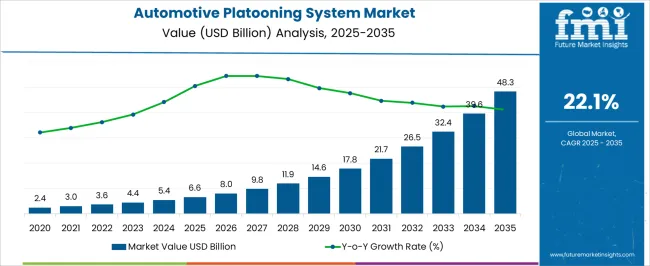
| Metric | Value |
|---|---|
| Automotive Platooning System Market Estimated Value in (2025 E) | USD 6.6 billion |
| Automotive Platooning System Market Forecast Value in (2035 F) | USD 48.3 billion |
| Forecast CAGR (2025 to 2035) | 22.1% |
The automotive platooning system market is experiencing accelerated growth, driven by the rising need for fuel efficiency, road safety, and optimized logistics across global transport networks. Increasing investments in connected vehicle technologies, coupled with advancements in advanced driver assistance systems and autonomous functionalities, are reshaping the industry landscape. Governments and regulatory authorities in leading economies are actively supporting intelligent transportation systems to reduce emissions and improve road utilization, providing a favorable environment for platooning adoption.
Enhanced wireless communication infrastructure and the integration of artificial intelligence into vehicle platforms are enabling real-time coordination between platooned vehicles, thereby improving operational efficiency and safety. The market is also benefiting from the logistics sector’s emphasis on reducing delivery costs and environmental footprints.
As commercial fleets continue to expand and digitization in transportation deepens, platooning systems are positioned to become a central feature of freight mobility solutions The focus on developing standards for inter-vehicle communication and ensuring interoperability across manufacturers is expected to further support long-term growth.
The automotive platooning system market is segmented by vehicle type, mode of communication, and geographic regions. By vehicle type, automotive platooning system market is divided into Heavy Commercial Vehicles and Light Commercial Vehicles. In terms of mode of communication, automotive platooning system market is classified into Vehicle to Vehicle (V2V) and Vehicle to Infrastructure (V2I). Regionally, the automotive platooning system industry is classified into North America, Latin America, Western Europe, Eastern Europe, Balkan & Baltic Countries, Russia & Belarus, Central Asia, East Asia, South Asia & Pacific, and the Middle East & Africa.

The heavy commercial vehicles segment is projected to hold 57.8% of the automotive platooning system market revenue share in 2025, making it the dominant vehicle type. This leadership is being reinforced by the segment’s central role in long-haul freight transport, where fuel savings and operational efficiency have a significant financial impact. Platooning systems in heavy commercial vehicles allow multiple trucks to operate in close formation, reducing aerodynamic drag and lowering overall fuel consumption.
The demand for improved logistics efficiency and reduced carbon emissions has encouraged widespread adoption of platooning technologies in this category. Fleet operators are increasingly prioritizing solutions that deliver measurable cost savings while aligning with sustainability objectives. Additionally, regulatory pushes for cleaner transportation and government-led pilot projects have accelerated deployment in commercial fleets.
The compatibility of platooning systems with existing telematics platforms and fleet management solutions is further supporting adoption As logistics chains expand globally and emphasis on digital transformation in transportation increases, heavy commercial vehicles are expected to maintain their leadership within the market.
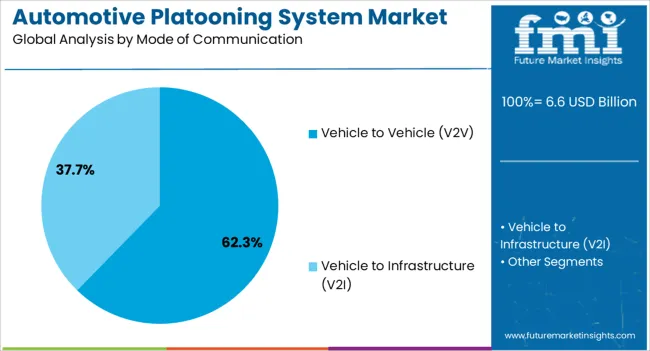
The vehicle to vehicle communication segment is anticipated to account for 62.3% of the automotive platooning system market revenue share in 2025, positioning it as the leading mode of communication. This dominance is being driven by the critical need for direct, real-time data exchange between vehicles within a platoon to ensure coordinated acceleration, braking, and lane changes. The ability of V2V communication to provide ultra-low latency and high reliability has established it as the preferred standard for platooning operations.
Growing deployment of dedicated short-range communication and cellular vehicle-to-everything technologies has further strengthened its role. By enabling precise synchronization, V2V communication enhances road safety, reduces human intervention, and improves overall efficiency in freight transport.
Industry stakeholders are focusing on creating interoperable communication protocols to facilitate seamless connectivity across diverse vehicle fleets, which is accelerating adoption As 5G infrastructure continues to expand, the effectiveness and scalability of V2V systems are expected to improve further, reinforcing their leadership in enabling widespread platooning adoption across global logistics and transportation networks.
Adoption of Automotive Platooning Systems in Commercial Fleets to Surge
The adoption of automotive platooning systems in commercial fleets is rising due to several factors. One of the primary growth factors influencing the automotive platooning system market is the significant potential for cost savings, especially in fuel consumption.
By utilizing advanced communication technologies, vehicles in a platoon can maintain closer distances to each other, reducing air drag and improving fuel efficiency. This reduction in fuel costs is particularly attractive to commercial fleet operators, who face substantial expenses in this area.
Another key factor is the enhancement of safety. Platooning systems leverage vehicle-to-vehicle (V2V) communication to synchronize braking and acceleration among the platooned vehicles.
This reduces the likelihood of human error, which is a leading cause of accidents. Automated and synchronized responses to traffic conditions can help prevent collisions, thereby improving road safety and reducing the costs associated with accidents, including repairs, insurance, and downtime.
Impact of Autonomous Driving Technology on the Automotive Platooning System Market
Autonomous driving technology is profoundly impacting the automotive platooning system sector by enhancing the feasibility and effectiveness of platooning. One of the key market trends in automotive platooning systems is the integration of advanced sensor and data processing capabilities that enable precise and reliable vehicle control.
Autonomous systems equipped with LIDAR, radar, and advanced cameras provide real-time data that is crucial for maintaining optimal spacing, speed, and synchronization between platooned vehicles. This technological synergy ensures smoother and safer operation of platoons, thereby increasing attractiveness to fleet operators.
Market Penetration of Automotive Platooning Systems in Logistics and Transportation
The market penetration of automotive platooning systems in logistics and transportation is steadily increasing, driven by the tangible benefits and growing acceptance of this technology. A key factor in this penetration is the enhancement of supply chain efficiency.
Automotive platooning allows logistics companies to optimize transportation routes and schedules, reducing transit times and improving the reliability of deliveries. This optimization is particularly beneficial for industries reliant on just-in-time delivery models, where timely and consistent delivery is crucial.
The scalability of platooning technology facilitates its adoption in various fleet sizes and types. Whether it's a small fleet of delivery trucks or a large convoy of freight haulers, platooning systems can be adapted to different operational needs. This flexibility encourages a wide range of logistics and transportation companies to invest in platooning technology, contributing to surging adoption.
Regulatory Uncertainty and Availability of Alternatives Hamper Demand
The market size of automotive platooning systems is experiencing a decline due to several specific and nuanced factors. One such factor is the increased competition from other emerging transportation technologies.
The rapid development and deployment of fully autonomous vehicles, electric trucks, and advanced driver-assistance systems (ADAS) offer alternative solutions for improving efficiency and safety in logistics. These technologies often provide similar or greater benefits without the need for closely coordinated vehicle groupings, making these more attractive to some fleet operators.
Another reason is the regulatory uncertainty surrounding platooning systems. While there have been supportive measures, inconsistent regulations across different regions and countries pose significant challenges.
Variations in road safety laws, communication standards, and operational guidelines make it difficult for companies to implement platooning systems on a large scale. This regulatory fragmentation can deter investment as companies seek more predictable and uniform regulatory environments.
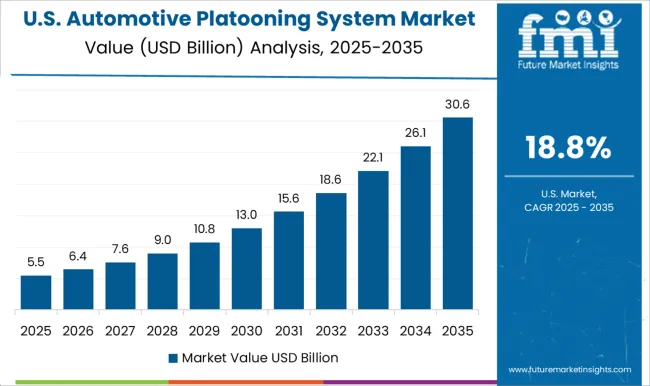
Market opportunities for automotive platooning systems in reducing carbon emissions in the United States are substantial. It is pushed by growing environmental regulations and corporate sustainability goals.
The country's government has been increasingly focused on reducing greenhouse gas emissions, particularly in the transportation sector, which is a key contributor to carbon pollution. This regulatory pressure creates a favorable market for technologies like platooning that can demonstrably reduce fuel consumption and, consequently, carbon emissions.
Collaboration with environmental organizations and initiatives presents a leading opportunity in China. Partnerships with NGOs and participation in carbon reduction programs can provide companies with additional resources, publicity, and support for implementing platooning systems. These collaborations can amplify the environmental benefits of platooning and encourage wide adoption across the industry.
The rise of environmental, social, and governance (ESG) investing is also creating growth in automotive platooning systems in China. Investors are increasingly looking to fund companies that prioritize sustainability and have robust ESG practices. Companies that adopt platooning technologies can attract these investors by demonstrating their commitment to reducing carbon emissions and improving operational efficiency.
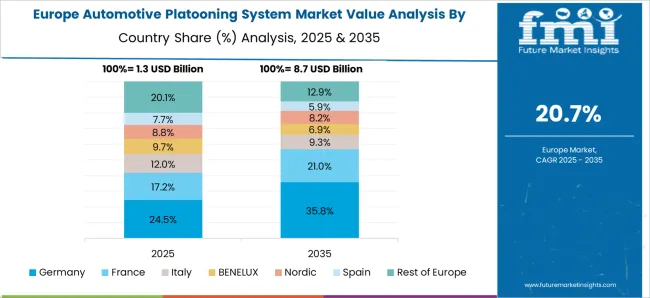
Analysis of fuel efficiency improvements through automotive platooning systems in Germany shows that automotive platooning systems significantly improve fuel efficiency by leveraging aerodynamic benefits. When vehicles travel closely together in a platoon, the lead vehicle reduces air resistance for the following vehicles, allowing these to conserve fuel.
The aerodynamic advantage is akin to the slipstream effect used in cycling and racing, where trailing participants use less energy to maintain speed. Improvements in fuel efficiency directly translate to lower operational costs for fleet operators and reduced carbon emissions, making platooning a compelling option for the logistics industry.
In terms of automotive platooning system market segmentation, demand for platooning systems in light commercial vehicles is rising. This is mainly due to the increasing need for enhanced logistical efficiency in urban and suburban areas. Electric light commercial vehicles are often used for last-mile delivery services, where quick and reliable transportation is crucial.
Platooning technology enables these vehicles to move efficiently through traffic by maintaining optimal speed and distance from each other, reducing congestion and delivery times. This is particularly beneficial in densely populated areas where traffic delays can significantly impact delivery schedules and customer satisfaction.
The automotive platooning system market share dynamics suggests demand for vehicle to vehicle (V2V) communication is rising due to its critical role in advancing autonomous driving capabilities. V2V communication allows vehicles to share real-time data about their speed, position, and direction, which is essential for enabling autonomous vehicles to make informed decisions quickly.
The constant exchange of information enhances the situational awareness of autonomous systems, allowing these to react to changing road conditions, sudden obstacles, and other vehicles' movements more effectively. As the development of autonomous vehicles accelerate, the need for robust V2V communication infrastructure becomes increasingly vital to ensure safe and efficient operation.

The competitive landscape of the automotive platooning system industry is characterized by a mix of established automotive giants, specialized technology firms, and emerging start-ups, all vying for high share. Leading automakers such as Daimler, Volvo, and Scania are heavily investing in platooning technologies, leveraging extensive resources and established presence.
A few companies are integrating platooning systems into the existing commercial vehicle lines, enhancing their appeal by offering comprehensive, end-to-end solutions for fleet operators. Their efforts are often complemented by partnerships with technology firms to advance V2V communication and automation technologies.
Industry Updates
Light and heavy commercial vehicles are two key vehicle types.
Vehicle to vehicle (V2V) and vehicle to infrastructure (V2I) are the two key communication modes.
Key countries of North America, Latin America, Western Europe, South Asia, East Asia, Eastern Europe, and the Middle East and Africa have been covered in the report.
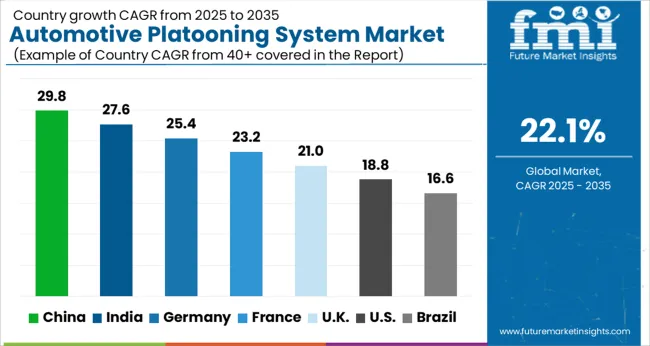
| Country | CAGR |
|---|---|
| China | 29.8% |
| India | 27.6% |
| Germany | 25.4% |
| France | 23.2% |
| UK | 21.0% |
| USA | 18.8% |
| Brazil | 16.6% |
The Automotive Platooning System Market is expected to register a CAGR of 22.1% during the forecast period, exhibiting varied country level momentum. China leads with the highest CAGR of 29.8%, followed by India at 27.6%. Developed markets such as Germany, France, and the UK continue to expand steadily, while the USA is likely to grow at consistent rates. Brazil posts the lowest CAGR at 16.6%, yet still underscores a broadly positive trajectory for the global Automotive Platooning System Market. In 2024, Germany held a dominant revenue in the Western Europe market and is expected to grow with a CAGR of 25.4%. The USA Automotive Platooning System Market is estimated to be valued at USD 2.4 billion in 2025 and is anticipated to reach a valuation of USD 13.4 billion by 2035. Sales are projected to rise at a CAGR of 18.8% over the forecast period between 2025 and 2035. While Japan and South Korea markets are estimated to be valued at USD 310.8 million and USD 166.5 million respectively in 2025.
| Item | Value |
|---|---|
| Quantitative Units | USD 6.6 Billion |
| Vehicle Type | Heavy Commercial Vehicles and Light Commercial Vehicles |
| Mode of Communication | Vehicle to Vehicle (V2V) and Vehicle to Infrastructure (V2I) |
| Regions Covered | North America, Europe, Asia-Pacific, Latin America, Middle East & Africa |
| Country Covered | United States, Canada, Germany, France, United Kingdom, China, Japan, India, Brazil, South Africa |
| Key Companies Profiled | Daimler, Peloton Technology, Scania, Volvo, Continental, Delphi, IVECO, MAN Truck & Bus, Meritor Wabco, Navistar, Nokia Growth Partners, and TomTom |
The global automotive platooning system market is estimated to be valued at USD 6.6 billion in 2025.
The market size for the automotive platooning system market is projected to reach USD 48.3 billion by 2035.
The automotive platooning system market is expected to grow at a 22.1% CAGR between 2025 and 2035.
The key product types in automotive platooning system market are heavy commercial vehicles and light commercial vehicles.
In terms of mode of communication, vehicle to vehicle (v2v) segment to command 62.3% share in the automotive platooning system market in 2025.






Full Research Suite comprises of:
Market outlook & trends analysis
Interviews & case studies
Strategic recommendations
Vendor profiles & capabilities analysis
5-year forecasts
8 regions and 60+ country-level data splits
Market segment data splits
12 months of continuous data updates
DELIVERED AS:
PDF EXCEL ONLINE
Automotive Performance Part Market Size and Share Forecast Outlook 2025 to 2035
Automotive Carbon Ceramic Brake Market Size and Share Forecast Outlook 2025 to 2035
Automotive Camshaft Market Size and Share Forecast Outlook 2025 to 2035
Automotive Stamping Industry Analysis in India Size and Share Forecast Outlook 2025 to 2035
Automotive Cylinder Liner Market Size and Share Forecast Outlook 2025 to 2035
Automotive Microcontroller Market Size and Share Forecast Outlook 2025 to 2035
Automotive Roof Rails Market Size and Share Forecast Outlook 2025 to 2035
Automotive Diagnostic Scan Tool Market Size and Share Forecast Outlook 2025 to 2035
Automotive Test Equipment Market Size and Share Forecast Outlook 2025 to 2035
Automotive Dynamic Map Data Market Size and Share Forecast Outlook 2025 to 2035
Automotive Green Tires Market Size and Share Forecast Outlook 2025 to 2035
Automotive E-Tailing Market Size and Share Forecast Outlook 2025 to 2035
Automotive Interior Market Forecast Outlook 2025 to 2035
Automotive Key Market Size and Share Forecast Outlook 2025 to 2035
Automotive Appearance Chemical Market Forecast and Outlook 2025 to 2035
Automotive Seating Market Forecast and Outlook 2025 to 2035
Automotive Domain Control Module Market Forecast and Outlook 2025 to 2035
Automotive Remote Diagnostic Market Forecast and Outlook 2025 to 2035
Automotive Thin IGBT Module Market Size and Share Forecast Outlook 2025 to 2035
Automotive Hydrogen Leak Detection Sensors Market Size and Share Forecast Outlook 2025 to 2035

Thank you!
You will receive an email from our Business Development Manager. Please be sure to check your SPAM/JUNK folder too.
Chat With
MaRIA